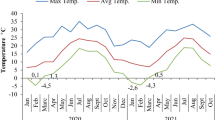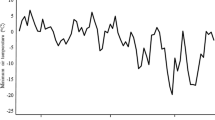Abstract
In this study, the cold hardiness degrees of the main grape cultivars grown in the temperate climatic conditions of Samsun province, Turkiye were determined using the tissue browning technique. Winter canes were prepared as single nodes cuttings in the coldest month of February. After an artificial freeze test, LT50 degrees of primary, secondary, tertiary buds, and phloem tissue were determined. In addition, after the freeze test, some growth and rooting parameters of single-bud cuttings were examined in a growing room condition. The highest LT50 values in primary, secondary, and tertiary buds were observed in ‘Karaerik’, ‘Alphonse Lavallee’, ‘Çeliksu’ and ‘Merzifon Karası’ cultivars. Highest primary bud LT50 values were obtained as – 24.3 °C in ‘Karaerik’, – 23.1 °C in ‘Çeliksu’, – 22.9 °C in ‘Alphonse Lavallee’, and – 22.1 °C in ‘Merzifon Karası’ cultivars. The lowest primary bud LT50 values were found in ‘Narince’, ‘Çavuş’, and ‘Trakya İlkeren’ cultivars ( – 11.0 °C, – 12.1 °C, and – 16.1 °C, respectively). While phloem viability rate was 77.3% in ‘Çeliksu’, it was determined as 8.0% in the ‘Çavuş’ cultivar. The highest primary, secondary, and tertiary bud viability was determined in the ‘Karaerik’ cultivar (64.7%, 67.3%, and 68.0%, respectively). On the other hand, the least bud viability rates were obtained in ‘Çavuş’, ‘Narince’, and ‘Trakya İlkeren’ cultivars. In the growing room condition, the highest mean bud burst (60.7%), bud sprouting ratio (61.0%), and cluster number per shoot (0.42 cluster) were obtained in the ‘Çeliksu’ cultivar in growing room condition. The highest mean shoot length (4.8 cm), rooting ratio (59.3%), root length (4.10 cm), and root scale (1.19) were determined in the ‘Karaerik’ cultivar among freeze applied cuttings.











Similar content being viewed by others
Data availability
Data available on request from the authors.
References
Alleweldt G, Spiegel-Roy P, Reisch B (1991) Grapes (Vitis). Genet Resour Temp Fruit Nut Crops 290:291–330
Andrews PK, Sandidge CR, Toyama TK (1984) Deep supercooling of dormant and deacclimating Vitis buds. Am J Enol Vitic 35(3):175–177. https://doi.org/10.5344/ajev.1984.35.3.175
Antivilo FG, Paz RC, Tognetti J, Keller M, Cavagnar M, Barrio EE, Juñent FR (2020) Winter injury to grapevine secondary phloem and cambium impairs budbreak, cambium activity, and yield formation. J Plant Growth Regul 39:1095–1106. https://doi.org/10.1007/s00344-019-10051-w
Anvarbekova CA, Ergasheva D (2021) Current requirements for external environmental factors. Galaxy Int Interdiscip. Res J 9(12):663–665
Dami IE, Ennahli S, Zhang Y (2012) Assessment of Winter injury in grape cultivars and pruning strategies following a freezing stress event. Am J Enol Viti 63(1):106–111. https://doi.org/10.5344/ajev.2011.11040
Dami IE, Li S, Zhang Y (2016) Evaluation of primary bud freezing tolerance of twenty-three winegrape cultivars new to the eastern United States. Am J Enol Vitic 67(2):139–145. https://doi.org/10.5344/ajev.2015.15047
DeKrey DH, Klodd AE, Clark MD, Blanchette RA (2022) Grapevine trunk diseases of cold-hardy varieties grown in Northern Midwest vineyards coincide with canker fungi and winter injury. PLoS One 17(6):e0269555. https://doi.org/10.1371/journal.pone.0269555
Dhekney SA, Basford AT, Chhatre VE, Rosenberg MB, Claflin C, Sessions SK, Li, ZJ, Gray DJ (2020) Vitis spp. grape. In Biotech Fruit Nut Crops (pp. 655–674). Wallingford UK: CAB International. https://doi.org/10.1079/9781780648279.065
Doğan O, Kara Z, Yazar K, Sabir A (2018) Freezing tolerance of some grape cultivars and rootst°Cks. In XXX International Horticultural Congress IHC2018: International Symposium on Viticulture: Primary Production and Processing 1276 (pp. 223–230). https://doi.org/10.17660/ActaHortic.2020.1276.32
Ershadi A, Karimi R, Mahdei KN (2016) Freezing tolerance and its relationship with soluble carbohydrates, proline and water content in 12 grapevine cultivars. Acta Physiol Plant 38:1–10. https://doi.org/10.1007/s11738-015-2021-6
Fennell A (2004a) Freezing tolerance and injury in grapevines. J Crop Improv 10(1–2):201–235. https://doi.org/10.1300/J411v10n01_09
Fennell A (2004b) Freezing tolerance and injury in grapevines. In Adaptations and Responses of Woody Plants to Environmental Stresses. R. Arora (Ed.), pp. 201–235. Hawthorn Press, Binghamton, NY. https://doi.org/10.1300/J411v10n01_09
Ferguson JC, Tarara JM, Mills LJ, Grove GG, Keller M (2011) Dynamic thermal time model of cold hardiness for dormant grapevine buds. Ann Bot 107:389–396. https://doi.org/10.1093/aob/mcq263
Ferguson JC, Moyer MM, Mills LJ, Hoogenboom G, Keller M (2014) Modeling dormant bud cold hardiness and budbreak in twenty-three Vitis genotypes reveals variation by region of origin. Am J Enol Vitic 65:59–71. https://doi.org/10.5344/ajev.2013.13098
Gonzalez Antivilo F, Paz RC, Tognetti J, Keller M, Cavagnaro M, Barrio EE, Roig Juñent F (2020) Winter injury to grapevine secondary phloem and cambium impairs budbreak, cambium activity, and yield formation. J Plant Growth Regul 39:1095–1106. https://doi.org/10.1007/s00344-019-10051-w
Hamman RA, Dami IE, Walsh TM, Stushnoff C (1996) Seasonal carbohydrate changes and cold hardiness of Chardonnay and Riesling grapevines. Am J Enol Vitic 47(1):31–36. https://doi.org/10.5344/ajev.1996.47.1.31
Howell GS, Stergios BG, Stackhouse SS (1978) Interrelation of productivity and cold hardiness of Concord grapevines. Am J Enol Vitic 29:187–191. https://doi.org/10.5344/ajev.1978.29.3.187
Jackson RS (2014) Wine Science: Principles and Applications, 4th edn. Academic Press, Cambridge
Kalkan NN, Kaya Ö, Karadoğan B, Köse C (2017) Determination of cold damage and lipid peroxidation levels of Karaerik (Vitis vinifera L.) grape cultivar having different trunk height in Winter Buds (in Turkish). Alınteri Zirai Bilimler Dergisi https://doi.org/10.28955/alinterizbd.297798
Karimi R (2020) Cold hardiness evaluation of 20 commercial table grape (Vitis vinifera L.) cultivars. Int J Fruit Sci 20(3):433–450. https://doi.org/10.1080/15538362.2019.1651242
Kaya Ö, Köse C (2018) Effects of cold damage on grapevine. Yyu J Agr Sci 28(2):241–253 (in Turkish). https://doi.org/10.29133/yyutbd.405252
Kaya Ö, Köse C (2020) How pretest temperatures change the cold hardiness of grapevine (Vitis vinifera L. Cv. Karaerik) dormant buds? Int J Fruit Sci 20 (sup3): 470–1482. https://doi.org/10.1080/15538362.2020.1804516
Kaya HB, Dilli Y, Öncü-Öner T, Ünal A (2023) Exploring genetic diversity and population structure of a large grapevine (Vitis vinifera L.) germplasm collection in Türkiye. Frontiers in Plant Sci 14: 1121811. https://doi.org/10.3389/fpls.2023.1121811
Kaya Ö (2019) Cold hardiness assessment of four grape cultivars using the tissue browning method in Erzincan. 2nd International Congress on Engineering and Life Sciences. 11–14 April 2019, Kastamonu, Turkiye.
Keller M (2015) The science of grapevines-anatomy and physiology, 2nd edn. Academic Press, Burlington
Keller M, Mills LJ, Olmstead MA (2014) Fruit ripening has little influence on grapevine cold acclimation. Am J Enol Vitic 65(4):417–423
Keller M, Mills LJ (2007) Effect of pruning on recovery and productivity of cold-injured merlot grapevines. Am J Enol Vitic 58:351–357. https://doi.org/10.5344/ajev.2007.58.3.351
Köse C, Kaya Ö (2017) Determination of resistance to low temperatures of winter buds according to position in Karaerik (V. vinifera L.) grape cultivar. Int J Scient Res Public 7(4):4–5. https://doi.org/10.1007/s11738-017-2513-7
Köse B, Ateș S, Çelik H (2014) Determination of late spring frost affections on some grape varieties grown in Samsun. Turk J Agric Res 1(2): 162–169. https://doi.org/10.19159/tutad.91587
Küpe M, Köse C (2019) Determination of cold damage in field and laboratory conditions in dormant buds of Karaerik grape cultivar. Atatürk Univ J. Agric Faculty 50 (2): 115–121. https://doi.org/10.17097/ataunizfd.522485
Lave LB (1963). The value of better weather information to the raisin industry. Econometrica 151–164
Mancuso S, Fiorino P (2000) Differential thermal analysis, supercooling and cell viability in organs of Olea europaea at subzero temperatures. Adv Hortic Sci 14:1000–1005
MGM (2022) Turkish state meteorological service (https://www.mgm.gov.tr/eng/forecast-cities.aspx?m=SAMSUN)
Mills LJ, Ferguson JC, Keller M (2006) Cold-hardiness evaluation of grapevine buds and cane tissues. Am J Enol Vitic 57:194–200. https://doi.org/10.5344/ajev.2006.57.2.194
Monteiro AI, Malheiro AC, Bacelar EA (2021) Morphology, physiology and analysis techniques of grapevine bud fruitfulness: a review. Agriculture 11(2):127. https://doi.org/10.3390/agriculture11020127
Moran RE, Sun Y, Geng F, Zhang D, Fazio G (2011) Cold temperature tolerance of trunk and root tissues in one-or two-year-old apple rootstoks. Hort Sci 46:1460–1464. https://doi.org/10.21273/HORTSCI.46.11.1460
Moyer M, Mills LJ, Hoheisel GA, Keller M (2019) Assessing and managing cold damage in Washington vineyards (https://hdl.handle.net/2376/16677).
Mullins MG, Bouquet A, Williams LE (1992) Biology of the grapevine. Cambridge University Press
North M, Workmaster BA, Atucha A (2021) Cold hardiness of cold climate interspecific hybrid grapevines grown in a cold climate region. Am J Enol Vitic 72(4):318–327. https://doi.org/10.5344/ajev.2021.21001
Odneal MB (1984) Cold hardiness of grapes. State Fruit Experiment Station, College of Health and Applied Sciences, Missouri State University, Bulletin, 41
Özgür (2019) The effect on low-temperature resistantance of dormant buds and bud fertility of brined vine leaves harvest at Narince grape cultivar. Ms Thesis, Gaziosmanpasa University Graduate School of Natural and Applied Sciences Department of Horticulture, Tokat, Turkiye (in Turkish)
Pierquet P, Stushnoff C (1980) Relationship of low temperature exotherms to cold injury in Vitis riparia Michx. Am J Enol Vitic 31:1–6
Poni S, Sabbatini P, Palliotti A (2022) Facing spring frost damage in grapevine: recent developments and the role of delayed winter pruning–a review. Am J Enol Vitic 73(4):211–226. https://doi.org/10.5344/ajev.2022.22011
Pratt C, Pool RM (1981) Anatomy of recovery of canes of Vitis vinifera L. from simulated freezing injury. Am J Enol Vitic 32:223–227. https://doi.org/10.5344/ajev.1981.32.3.223
Quamme HA (1983) Relationship of air temperature to water content and supercooling of overwintering peach flower buds. J Am Soc Hortic Sci 108:697–701. https://doi.org/10.21273/JASHS.108.5.697
Rahemi A, Fisher H, Carter K, Taghavi T (2022) Mitigating grapevine winter damage in cold climate areas. Hortic Sci 49(2): 59–70. https://doi.org/10.17221/176/2020-HORTSCI
Sarikhani H, Haghi H, Ershadi A, Esna-Ashari M, Pouya M (2014) Foliar application of potassium sulphate enhances the cold-hardiness of grapevine (Vitis vinifera L.). J Hortic Sci Biotech 89(2): 141–146. https://doi.org/10.1080/14620316.2014.11513060
Shaw TB (2017) Climate change and the evolution of the Ontario cool climate wine regions in Canada. J Wine Res 28(1):13–45. https://doi.org/10.1080/09571264.2016.1238349
Singh SP (1999) Potential of diversification towards high value crops in Maharashtra. Agric Econ Res Rev 12(2):137–150
Svyantek A, Köse B, Stenger J, Auwarter C, Hatterman-Valenti H (2020) Cold-hardy grape cultivar winter injury and trunk re-establishment following severe weather events in North Dakota. Horticulturae 6(4):75. https://doi.org/10.3390/horticulturae6040075
Todaro TM, Dami IE (2017) Cane morphology and anatomy influence freezing tolerance in Vitis vinifera Cabernet franc. Int J Fruit Sci 17(4):391–406. https://doi.org/10.1080/15538362.2017.1330667
Wample RL, Wolf TK (1996) Practical considerations that impact vine cold hardiness. pp. 23–28. In: Henick-Kling T, Wolf TE and Harkness EM (eds.), Pro. 4th Intl. Symp. Cool Climate Viticulture and Enology. New York State Agricultural Experiment Station, Geneva, New York
Wolf TK, Cook MK (1994) Cold hardiness of dormant buds of grape cultivars: Comparison of thermal analysis and field survival. Hort Sci 29:1453–1455. https://doi.org/10.21273/HORTSCI.29.12.1453
Wolf TK, Warren MK (2000) Crop yield, grape quality and winter injury of eight wine grape cultivars in Northern Virginia. J Amer Pomol Soc 54:34–43
Zabadal TJ, Dami IE, Goffinet MC, Martinson TE, Chien ML (2007) Winter injury to grapevines and methods of protection. Michigan State University Publications on Grape Production, Michigan, pp 36–37
Author information
Authors and Affiliations
Contributions
BK conceptualized the topic addressed in the paper and wrote the manuscript. BK, YU, KB, and FT helped to collect samples from field and laboratory studies. BK evaluated the results and statistical analysis. BK, YU, KB, and FT were responsible for the performance of the research.
Corresponding author
Ethics declarations
Conflict of interest
The authors have no competing interests to declare that are relevant to the content of this article.
Consent for publication
All authors consent for the manuscript to be published.
Additional information
Publisher's Note
Springer Nature remains neutral with regard to jurisdictional claims in published maps and institutional affiliations.
Rights and permissions
Springer Nature or its licensor (e.g. a society or other partner) holds exclusive rights to this article under a publishing agreement with the author(s) or other rightsholder(s); author self-archiving of the accepted manuscript version of this article is solely governed by the terms of such publishing agreement and applicable law.
About this article
Cite this article
Köse, B., Uray, Y., Bayram, K. et al. Cold hardiness degrees of some Vitis vinifera L. and Vitis labrusca L. cultivars grown in temperate climate condition. Rend. Fis. Acc. Lincei 35, 253–262 (2024). https://doi.org/10.1007/s12210-024-01224-1
Received:
Accepted:
Published:
Issue Date:
DOI: https://doi.org/10.1007/s12210-024-01224-1




